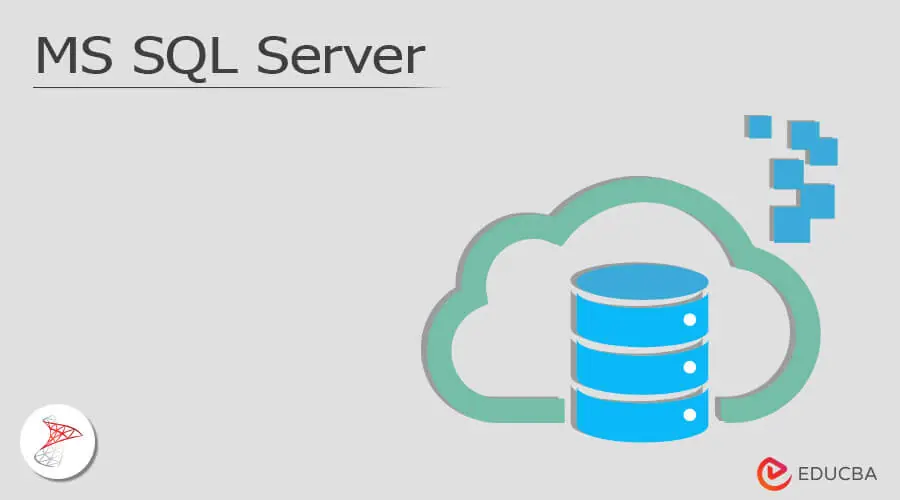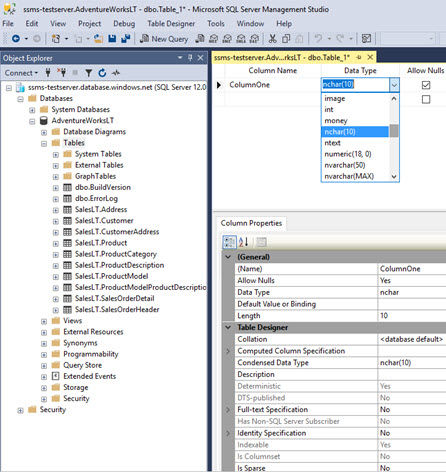Updated March 15, 2023
Introduction to MS SQL Server
People often confuse SQL server as a language or a database, as the term contains SQL, which stands for Structured Query Language. Yes, an SQL server is a database like any other relational database system which Microsoft and not a language develops. Server is also known as SQL server or MSSQL. In this article, we will use MSSQL or Microsoft SQL for refereeing the server.
Microsoft designed the server to compete with other databases such as Oracle.MSSQL or Microsoft SQL supports the ANSI SQL, the standard for the language, and also incorporates T – SQL, which is Microsoft’s implementation of SQL. In addition, MSSQL uses SQL Server Management Studio (SSMS) as an interface tool for interacting with the database, which supports both 32 – bit and 64 – bit environments.
Below is an image of the SSMS.
(Image source: https://docs.microsoft.com/en-us/sql/ssms/visual-db-tools/design-tables-visual-database-tools?view=sql-server-2017)
History
Microsoft released the first version in partnership with Sybase (“Sybase was an enterprise software and services company that produced software to manage and analyze information in relational databases” – according to Wikipedia) in 1989.
Below is a list of some of the versions that were released (Table from Wikipedia):
| Version | Year | SQL Release name | Code Name | Internal database version |
| 1.0 (OS/2) | 1989 | Server 1.0 (16-bit) | Filipi | – |
| 1.1 (OS/2) | 1991 | Server 1.1 (16-bit) | Pietro | – |
| 4.2A (OS/2) | 1992 | Server 4.2A (16-bit) | – | – |
| 4.2B (OS/2) | 1993 | Server 4.2B (16-bit) | – | – |
| 4.21a (WinNT) | 1993 | Server 4.21a | SQLNT | – |
| 6 | 1995 | Server 6.0 | SQL95 | – |
| 6.5 | 1996 | Server 6.5 | Hydra | 408 |
| 7 | 1998 | Server 7.0 | Sphinx | 515 |
| – | 1999 | Server 7.0 OLAP Tools | Palato mania | – |
| 8 | 2000 | Server 2000 | Shiloh | 539 |
| 8 | 2003 | Server 2000 64-bit Edition | Liberty | 539 |
| 9 | 2005 | Server 2005 | Yukon | 611/612 |
| 10 | 2008 | Server 2008 | Katmai | 655 |
| 10.25 | 2010 | Azure SQL database (initial release) | Cloud database or CloudDB | |
| 10.5 | 2010 | Server 2008 R2 | Kilimanjaro (aka KJ) | 661 |
| 11 | 2012 | Server 2012 | Denali | 706 |
| 12 | 2014 | Server 2014 | Hekaton | 782 |
| 13 | 2016 | Server 2016 | – | 852 |
| 14 | 2017 | Server 2017 | – | 869 |
After the dissolution of the partnership between Microsoft and Sybase in 1999, Microsoft got to keep the name SQL server. From then on, Microsoft released many versions such as 2000, 2005, 2012, and 2017 the latest one with advanced features and better security. However, as of now, only the below SQL versions are supported by Microsoft:
- Server 2008[4]
- Server 2008 R2
- Server 2012
- Server 2014
- Server 2016
- Server 2017
MS SQL Server Editions
There are different versions of server which are made available by Microsoft; some of them are listed below:
Enterprise edition: This is the most expensive licensed edition of the server, which has all the features enabled by Microsoft. Some features include data warehousing and Web-enabled databases, especially for large enterprises with complex data architectures.
Standard edition: This is for small and medium-sized organizations and offers only standalone access to the data. This edition does not incorporate the hot-add memory feature, which allows the administrator to add memory while the database is still running (no downtime is required for adding the memory).
Workgroup edition: This edition is usually used by small offices as this edition can be hosted on small web servers. From the server 2012 edition, this functionality has been removed from the versions released after 2012.
Express edition: This is the free edition from Microsoft for server, which only contains the core database engine. It has no limit on the number of users or the databases supported but restricts the number of processors used to one. Furthermore, the max ram used is restricted to 1 GB, and the max capacity of 10 GB of database files.
Some of the other feature-centric editions of SQL servers include:
| Edition name | Edition description |
| Azure | Azure Database is the cloud-based version of SQL Server |
| Azure | Azure Data Warehouse is the cloud-based version of SQL Server in an MPP (massively parallel processing) |
| Compact (SQL CE) | The compact edition is an embedded database engine |
| Developer | SQL Server Developer Edition includes the same features as SQL Server Enterprise Edition |
| Embedded (SSEE) | SQL Server 2005 Embedded Edition is a specially configured named instance of the Server Express database engine which can be accessed only by certain Windows Services. |
| Evaluation | This is the trial edition |
| Fast Track | This edition supports business analytics and faster data warehousing features |
| LocalDB | It can also be used as an embedded database |
| Analytics Platform System (APS) | Formerly Parallel Data Warehouse (PDW |
| Data warehouse Appliance Edition | Pre-installed and configured as part of an appliance in partnership with Dell & HP based on the Fast Track architecture. This edition does not include SQL Server Integration Services, Analysis Services, or Reporting Services. |
Conclusion
SQL Server is a relational database system like Oracle, DB2, MongoDB, etc., developed by Microsoft and has all the features an RDBMS (relational database management system).
Recommended Articles
This has been a guide to MS SQL Server. Here we have discussed different editions of MS SQL server, the history of SQL servers, etc. You may also look at the following article to learn more –




